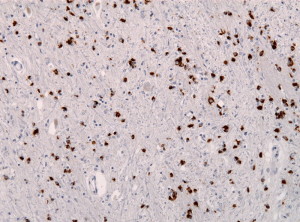[retweet][facebook]
Acupuncture increases drug efficacy for the treatment of multiple system atrophy (MSA). Formerly known as Shy-Drager Syndrome, MSA is an autonomic nervous system disorder affecting balance, coordination, and movement. Orthostatic hypotension is a key sign manifesting in dizziness upon standing. Additional symptoms include slowness of movement, rigidity, incontinence of urine, impaired speech, syncope, and tremors. Symptoms are manifestations of the progressive loss of function and death of brain and spinal cord nerve cells.
Researchers from Tianjin University of Traditional Chinese Medicine investigated the effects of acupuncture on patients receiving drug therapy for MSA. Patients receiving only drug therapy had a 45.5% total effective rate. However, patients receiving both acupuncture and drug therapy had a 90.9% total effective rate. The results of the acupuncture continuing education study were published in theShanghai Journal of Acupuncture and Moxibustion.
 Patients receiving drug therapy combined with acupuncture treatments experienced significantly less orthostatic hypotension. Consequently, there were significant reductions in dizziness and syncope associated with standing. Results were based on subject reports and stabilization of blood pressure. Other clinical improvements include improved hidrosis, eye movements, and bladder control. Patients also had significant reductions in tremors.
Patients receiving drug therapy combined with acupuncture treatments experienced significantly less orthostatic hypotension. Consequently, there were significant reductions in dizziness and syncope associated with standing. Results were based on subject reports and stabilization of blood pressure. Other clinical improvements include improved hidrosis, eye movements, and bladder control. Patients also had significant reductions in tremors.
Let’s take a look at the treatment protocols for both acupuncture and medications. Drug therapy consisted of oral midodrine hydrochloride tablets, 10 mg, three times per day for one month. Midodrine hydrochloride is an alpha1-agonist that activates alpha-adrenergic receptors to increase vascular tone and elevate blood pressure.
Acupuncture was administered with primary acupoint prescription for all patients combined with secondary acupoints for specific indications.
Mild reinforcing and reducing manual acupuncture techniques were administered. Upon the arrival of deqi, warm needle acupuncture was applied to CV6, CV4, and ST36. Total needle retention time was twenty minutes per acupuncture session.
The data demonstrates that an integrative medicine approach to MSA patient care produces superior patient outcomes. The randomized controlled trial demonstrates a 45.5% total effective rate for drugs as a standalone therapy. The combination of acupuncture with drug therapy boosts the total effective rate to 90.9%. The data warrants further investigation into the efficaciousness of acupuncture for the treatment of orthostatic hypertension in patients with MSA.
Excerpt from:
